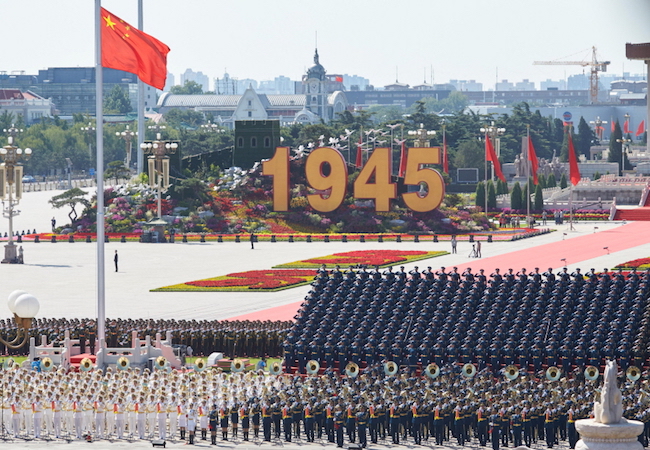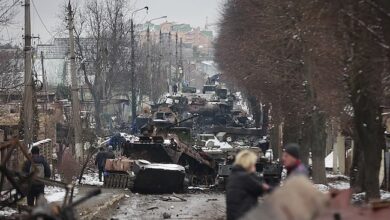Differences in the New Cold War with China

By Dr. Julian Spencer-Churchill
The new Cold War with China will be different in three fundamental respects from the First Cold War with the Soviet Union: the strategic arsenals will fortunately plateau at lower levels, nuclear crises will be about land bases rather than an ideological competition over foreign influence, and Chinese authoritarianism will be more durable than Soviet totalitarianism.
China will build fewer strategic nuclear weapons, but likely more tactical nuclear weapons. The Soviet Union’s trans-continental nuclear missiles swelled from zero in 1961 to 1300 in 1970 (with 1800 warheads), and then grew to 1398 missiles (with 7200 warheads) by 1980, with a total of 55,000 warheads manufactured. China had a Cold War peak of at most 1000-2000 warheads, which shrank to 320 in 2021, and is estimated to climb to its Cold war peak of 1000 by 2030. The difference is in confidence: Russian insecurity emanates from the geographic indefensibility of Russia’s plains, self-reliant responses to multiple catastrophic invasions in modern times (1812, 1914-1919, 1941-1945), and the conscious experience of being a target of genocide during the Second World War. Plutonium warhead production was therefore made priority by the Soviet politburo, and was never assigned an upper limit. The strategic culture in China, in contrast, is a synthesis of a modicum of cultural self-confidence, geographic defensibility, punctuated by a series of foreign humiliations. The nuclear strategic culture in China is therefore much more self-restrained. During the Cold War, Chinese leader Mao Zedong was publicly outspoken that China could not be destroyed by nuclear weapons.
China is more likely to emphasize a buildup of tactical nuclear weapons for its naval forces than the Soviet Union, given the absence of a powerful land-contiguous adversary against China, like West Germany. The US deployed approximately 8,000 nuclear warheads in Europe, mostly in the form of artillery shells, of which each could confidently disrupt a single battalion-sized formation of five hundred soldiers, dug in and dispersed, given good targeting intelligence. NATO and the Warsaw Pact had sufficient nuclear warheads for about two weeks of unrestrained combat. Naval warfare, by contrast, is far more about speculative use of ordinance. The Royal Navy dropped hundreds of depth charges and torpedoes against suspected Argentine submarines during the 1982 Falklands War, hitting none. Volleys of nuclear missiles will need to be launched against the layered defenses of surface flotillas, and the vast majority of theses missiles will be shot down. It is therefore expected that China will deploy at least as many nuclear warheads on its vessels as the US and USSR did during the Cold War, and likely much more given the larger fleet China is anticipated to deploy. This will make incidents at sea a much greater concern.
China’s push for hypersonic missiles are for collective psychological, rather than strategic advantage. China feels vulnerable as long as it is unable to bring the war home to Americans. Similarly, unable to respond to the onslaught of Allied strategic bombing of German cities, Adolf Hitler pushed for a vengeance rocket program of cruise missiles (V-1) ballistic missiles (A4/V-2), to be launched against Great Britain and Belgium. 23,172 V-1 cruise missiles (each costing 2 percent of a two-engined bomber), and 3,172 V-2 ballistic missiles (each costing 50 percent of a two-engined bomber), were launched. Both programs consumed fifty percent of the entire volume of explosives used by the German army, in effect, an enormously inefficient allocation of resources, given that only 16,000 persons, mostly civilians, were killed by these weapons. The War of the Cities, the exchange of missile attacks during the Iran-Iraq War, and Saddam Hussein’s onslaught of missiles against Israel and Saudi Arabia in 1991, were equally strategically insignificant. Japan’s launching of 6,000 explosive balloons towards the US and Canada during the Second World War, was an equally ineffective attempt to inflict punishment. China is compelled to demonstrate to itself and to the world the ability to hurt the US, despite the waste of resources.
Nuclear deterrence depends primarily on the high probability of a catastrophic response. As Nobel prize winner Thomas Schelling argued in his 1966 book, Arms and Influence, the speed of nuclear weapon is irrelevant to nuclear deterrence. William Borden, one of the earliest nuclear strategists, remarked in his 1946 book, There Will be No Time, that cities cannot escape nuclear destruction by missile, so they would be destroyed last, or held as hostages, and speed, again, is irrelevant. The key to the robustness of nuclear deterrence is that nuclear attacks cannot be defended against cost-effectively. This is argued by naval historian Bernard Brodie, likely the most influential nuclear strategist, in his 1946 book, The Absolute Weapon. An interceptor which must catch up and precisely hit a nuclear missile, will always cost a minimum of three of four times as much as its target, and is therefore more easily countered by simply building that many more offensive city-destroying missiles. While the US will be unable to shoot down a Chinese hypersonic weapon, China will be unable to shoot down the retaliating US ballistic missile and its decoys.
Hypersonic missiles do however have their uses in tactical warfare at sea, where missile speed will enable overcoming defensive anti-missile systems, and striking at fast-moving hostile fleets. Hypersonic missiles also have their political uses. If China were to detonate multiple nuclear warheads at 30,000 meters above the US, in a pattern to blind US radars with an electromagnetic pulse, the US would take that as an indicator of a full-scale attack, and would fire all of their Minuteman-III silo-based missiles at their targets in China. China would be devastated. If, following a US nuclear strike in China that destroys a single small city, China feels the need to retaliate, a single missile fired at a West coast city would likely be shot down by interceptors based as Fort Greely, Alaska, and Vandenberg Air Force Base, California. However, a hypersonic missile would facilitate a Chinese nuclear strike without provoking an escalation to a full-scale nuclear exchange.
The second difference in the new Cold War is China’s vulnerability to climate change. Its dependence on shrinking glacial water for its principal rivers, its critical weaknesses in the limited quantity of arable land per capita, and its shortage of fossil fuels, means that China’s strength will depend on maintaining access to international commerce. China’s greater dependence on trade, as compared with the Soviet Union, will lead Beijing to a far more aggressive pursuit of foreign ports and naval bases. While Cuba was a convenient missile platform for Moscow, Gwadar, Hambantota, and Djibouti are pearls along China’s energy lifeline. This will produce more intense proxy wars, but ones unfavorable to China, which will seek a far more militarily intrusive presence than the Soviet Union ever did among its base providers of Cam Ran Bay (Vietnam), Socotra (Yemen), or Latakia (Syria).
The third difference in this new Cold War, is that it may endure at least as long as the confrontation with the Soviet Union. The garrison state of the USSR, obsessed by a resurgent Germany, impoverished its population with the diversion of its scarce resources into weapons manufacturing. One third of the world’s tanks were in the armies of the Soviet Union, and at its peak, it possessed over 300 submarines, five times the number currently possessed by China. The Soviet Union depended as much on the Warsaw Pact as a defensible geographic buffer against a subsequent invasion from Western Europe, as it relied on it as a cultural bulwark against jeans, coke and rockn’roll. The Soviet Union collapsed because of the regime’s failure to provide consumer goods known to exist in the West, and not because of a political crisis.
The Communist regime in Beijing, however, is recognized by most Chinese as the deliverer of modernization and prosperity, and its endless war against corruption as an uncompromising pursuit of equality and fairness, regardless of the factional sub-text. Consequently, any containment policy akin to the Cold War strategy of cordoning off the Soviet Union until it generated a middle class sufficient to displace totalitarian communism, may never occur in China, if it ever occurred in the Soviet Union. Just as it took two draining global conflicts to knock German self-assuredness off of its pedestal, China’s assertive exceptionalism may be a factor of international politics for over a century. The world’s previous experience with centuries-long facts-of-politics of Spanish and French bellicosity, reminds us that the end of history may still be far off.
Dr. Julian Spencer-Churchill is associate professor of international relations at Concordia University, author of Militarization and War (2007) and of Strategic Nuclear Sharing (2014). and former Operations Officer, 3 Field Engineer Regiment. He has published extensively on South Asia, conducting research in Pakistan for over ten years. He teaches a course on the strategic studies of China.




